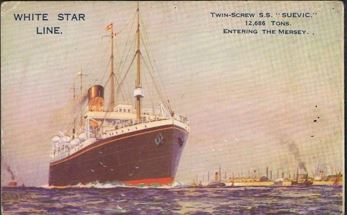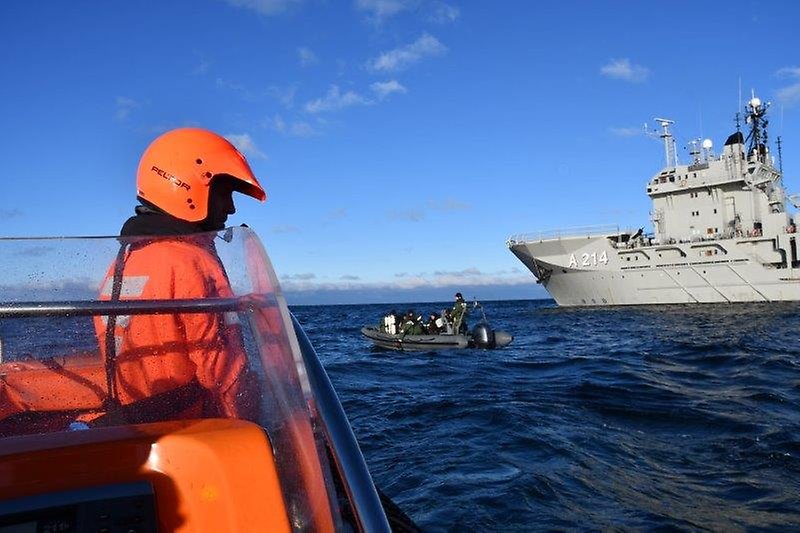Skytteren
During 2021 and 2022, the Swedish Agency for Marine and Water Management (SwAM) was responsible for salvage of oil from the shipwreck Skytteren. The work resulted in the successful removal of a total of 175,000 litres of oil and oil mixed with water from the wreck. Additionally, as part of the salvage operation, six ghost nets measuring a combined length of 120 to 180 meters were successfully removed.
The most environmentally hazardous shipwreck
The ship Skytteren sank on April 1, 1942, about ten kilometres from the Swedish west coast, near the city of Lysekil. The shipwreck is on the Swedish Maritime Administration’s list of environmentally hazardous wrecks in Swedish waters.
According to SwAM:s environmental risk assessment, Skytteren is ranked as number one on the list of the 30 most environmentally hazardous wrecks.
Skytteren is located near a sensitive archipelago, both in terms of the marine environment and beach areas. Further out to sea,the protected area of Bratten is situated, with large numbers of red-listed threatened species, for example corals and brittle stars. The entire coastline is highly valuable, especially concerning recreation and tourism.

Skytteren. Click on the photo.
Investigations of the shipwreck
In 2005, the Swedish Coast Guard performed an investigation of the wreck using a remotely operated underwater vehicle (ROV). Results showed that joints in the hull were corroded and that oil was leaking from a fracture in the hull.
In the autumn of 2018, SwAM and the Swedish Navy carried out a joint investigation of Skytteren for eight days (14-21 November). Since the shipwreck is located at a depth of approximately 74 meters, in an area with strong sea-floor currents, SwAM considered that the Navy’s divers where most suited for the task. The investigation was carried out from the Submarine Rescue Vessel HMS Belos. Deep divers participated from The Swedish Armed Forces Diving and Naval Medicine Centre, the 1st Submarine Flotilla and the 4th Naval Warfare Flotilla, as well as doctors and nurses for medical preparedness.
The purpose of the investigation in 2018 was to obtain more information for the risk assessment tool VRAKA for the assessment of environmentally hazardous wrecks. Hull thickness measurements were carried out where the fuel tanks are located. The divers searched for distinct changes or damages to the hull. The wreck was video- and photo documented to obtain data for the future oil recovery operation. Skytteren seemed to be in a relatively good condition at a first glance. However, measurements on the hull plates showed that they are heavily affected by corrosion and that they in specific areas only were 5 - 6 millimetres thick, which is less than one third of the original thickness. On the sea surface, a small but continuous oil spill was also detected during the investigations. It was not possible to backtrack where on the wreck the oil leaked from or to draw any certain conclusions on the amount of oil left in the wreck during this investigation.
During June-August 2020, further work was carried out on the wreck. With a high-quality camera mounted on an underwater robot, all parts of the 172 meter large wreck were digitally documented with almost 27,000 overlapping images. With a computer technology called photogrammetry, the digital photographs were assembled into a high-resolution image, which makes it possible to both get an overview of the entire wreck and to study specific areas at a detailed level. This data was initially used to study the extent of degradation of the wreck, and during the inspection for presence of oil in it, as well as in the salvage operation of the oil.
The investigation in 2020, and the analysis of the material (orthoimage and Digital Elevation Model, DEM), showed that the wreck's hull is still relatively complete but with signs of severe corrosion in some places. The stern is in worse condition than the rest of the wreck. There are several holes due to corrosion, but also a 4.2 meter long crack in the hull. In this area, the hull has a depression with a difference of 90 centimetres compared to the rest of the hull. This indicates a weakening that could lead to an impending collapse. The bilge keel was also been carefully examined, as this area is particularly interesting. Since the wreck lies on the side, the bilge keel is the highest point of the wreck, and therefore where the oil may have accumulated if leaked from the bunker tanks. No holes or damage to the hull was discovered in this area.
A third survey was conducted during February-March 2021 with the aim of discerning if, and where, the oil in the wreck is located. Divers performed about 60 penetrations of the hull at three different depths horizontally along the hull side. Where oil was found, a probe was inserted to enable a calculation of the lowest volume of oil in the tank in question. The penetration holes were re-sealed immediately after the examination of the tanks. However, it was not possible to examine the fuel tanks on the port side of the ship, since these tanks are located at the bottom towards the seabed. The data from this operation was essential in the salvage operation of the oil.
A salvage operation of oil and ghost nets was carried out on the wreck in mid-September 2021.
Salvage operation
Commencing in September 2021, the salvage operation addressed both oil and ghost net concerns. During the course of the operation, it became apparent that the wreck contained a particularly viscous type of oil or that the oil over time had fractionated so that some parts were highly viscous. This oil then obstructed the pump responsible for transporting the oil to tanks aboard the work vessel. This impediment necessitated the deployment of specialized equipment, to heat the oil inside the wreck's tanks, rendering it less viscous and using a stronger specialised pump, specifically a screw pump.
These altered operational conditions and non-favourable weather conditions, resulted in an extended period before the work could be completed. Consequently, the project experienced delays and had to be temporarily halted during the winter months. It wasn't until April 2022 that weather conditions permitted the resumption of work. Following approximately six days of intensive diving operations, the salvage work reached completion. The comprehensive undertaking involved skilled divers and an underwater robot.
Divers penetrated the hull of the wreck, at areas containing the oil, extracting it and using the pump transporting it to the work vessel at the surface. In total, 175,000 litres of oil and oil mixed with water were successfully pumped from the wreck. Additionally, the salvage team successfully cleared the wreck of six ghost nets, measuring a combined length of 120-180 meters, from the wreck.
Cost of measures taken
Investigations and salvage expenditure for oil and ghost nets at Skytteren:
- 2018 Survey: SEK 1,799,609
- 2020 Survey: SEK 1,548,000
- 2021 Survey: SEK 7,000,000
- 2021 Salvage: SEK 19,506,000
The financial resources for these initiatives have been allocated from the government's 1:4 grant, specifically designated for the clean-up and restoration of contaminated areas.
These costs of the project can be compared to costs associated with direct clean-up costs of oil from the sea and shoreline, and additional costs for environmental remediation and the economic impact of lost tourism post-oil spills. Typically, these costs are higher when compared to the preventative measure of salvaging oil from a wreck.
Background
The ship Skytteren was built in 1899-1900 by the shipping company White Star Line in Belfast and was then named Suevic. The same shipping company built the ships Titanic and Britannic. She served as an ocean liner and a reefer ship transporting emigrants and supplies between Europe, South Africa and Australia. After a wreckage in 1907, she was repaired in Southampton before returning to traffic. In 1928, she was sold to a Norwegian shipping company for £35,000 and was rebuilt into a whaling factory ship named Skytteren. During the Second World War, she ended up in Gothenburg and was taken over by the shipping company Nortraship.
On April 1, 1942, Skytteren and about ten other Nortraship ships made an attempt to break through the German blockade and reach the allies with cargo consisting of Swedish steel and ball bearings. The ship was shot at and damaged by the Germans. To avoid the valuable cargo being seized by the Germans, the captain chose to scuttle her. One crew member died and 110 were captured and put in German prison camps. The ship sank to the bottom immediately.
Here is a map of the most environmentally hazardous shipwrecks in Swedish waters.
Videos from Skytteren
See SwAM's youtube channel for videos from the diving investigation.
Photos from the investigation
Slideshow from the investigations of Skytteren. Photogrammetry images rendered in 2020 and photos from the press event on November 21, 2018, which attracted some 20 journalists.

.jpg)











.jpg)
.jpg)
.jpg)
.jpg)
.jpg)
.jpg)
.jpg)
.jpg)
.jpg)
.jpg)
.jpg)
.jpg)
.jpg)
.jpg)
.jpg)













.jpg)
.jpg)




